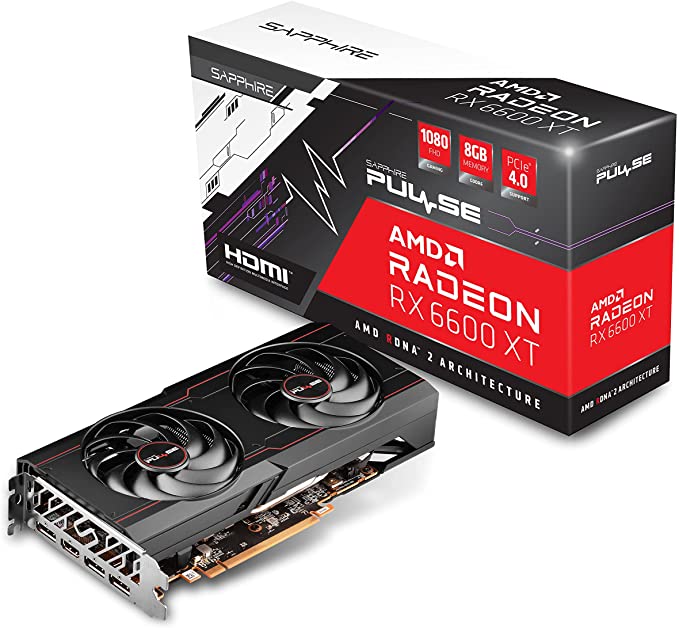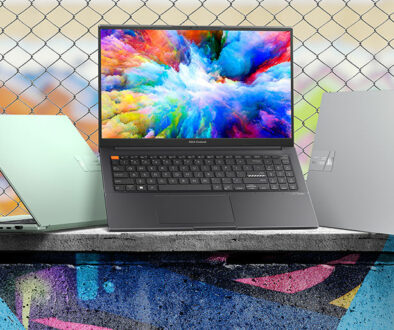Best Budget Graphics Cards in 2022 (Brand New)
GPU prices are finally going down! No really. According to multiple independent sources (Greg Salazar, Hardware Unboxed, etc.), since February 2022 overall prices of graphics cards have significantly fallen. It’s still nowhere near MSRP, of course. But at 140-170% MSRP, we can finally simply chalk it up to increased shipping costs and raw material price inflation.
As such, it is probably a good time now, at least before prices go up again due to a certain ongoing upheaval in Europe, to recommend the best budget graphics cards you can buy in early 2022.

Brand New Budget GPU 2022 Overview
- AMD Radeon RX 6500 XT
- Nvidia Geforce RTX 3050 8GB
- AMD Radeon RX 6600
- AMD Radeon RX 6600 XT
Honorable Mention: Ryzen 6000 series APUs

Not exactly part of our discrete selection, but we’d like to briefly mention the absolutely amazing RDNA 2.0-powered Zen 3+ APUs that finally made their way to the mobile market a few weeks ago. As expected, these highly advanced iGPUs were able to blow way past the already remarkable performance of previous VEGA-powered Ryzen APUs. Like, if the 3400G and 5600G showcased 750 Ti-levels of performance before, the new Ryzen 6000 APUs pushes the boundaries even further to almost the GTX 1050 Ti (possibly even up to GTX 1650 in some games).

So far, at the moment, we have only witnessed the raw power of the Ryzen 9 6900HS (Radeon 680M) and the Steam Deck’s custom Zen 3 APU. But, be on the lookout for future Ryzen 7 and Ryzen 5 offerings in the next few months if you are interested to enjoy this brand-new iGPU architecture.

Excluded Entry: Nvidia Geforce RTX 3060
Theoretically should have been the lower mid-tier entry for Nvidia’s Ampere architecture lineup. But alas, even after February 2022, the GPU is still significantly expensive, putting it an entire price tier away from its supposed competitor, the Radeon RX 6600 XT, which has since then lowered in retail price considerably. As such, we have decided to exclude the RTX 3060 from this list.
If, by any chance, you can strike a good RTX 3060 deal that is almost near the price of an RX 6600 XT, then go ahead and take it. But for now, we don’t recommend buying it as a budget option even if it arguably has better technology features like DLSS.
Hopefully this may change once again in the next few months.
1. Conditions Must Be Fulfilled: AMD Radeon RX 6500 XT
Tech Specs:
| Process node | 6nm |
| Architecture | RDNA 2.0 |
| GPU Cores | 1024 shader, 16 CU, 16 RT |
| Boost Clock | 2815 Mhz |
| VRAM | 4GB GDDR6 |
| Memory Bus | 64-bit |
| TFLOPS (FP32) | 5.765 |
| TDP | 107W |
| PCI power | 1x 6-pin |
| Bus Interface | PCIe 4.0 x4 |
| Paper MSRP | $250 |
| Actual Retail | $270-$350 |
| Equivalent GPU | RX 580, GTX 1060 6GB, GTX 1650 Super, etc. |
Generally lampooned due to its weird assortment of features and design choices, the originally laptop-based RX 6500 XT actually remains one of the best budget purchases if you are looking for a fairly competent GPU for 1080p medium-setting triple-A gaming. For one thing, it uses a modern architecture that is guaranteed support for several years. Also, they’re usually always in stock and available for purchase.

There are certain conditions, however, before the RX 6500 XT becomes the true budget GPU you are looking for. First, your motherboard’s main PCIe x16 slot must strictly support at least PCIe 4.0. Second, never run games at VRAM settings close to maximum. Third, be absolutely sure that you are not going to do any video encoding stuff (even in-game recording) on the GPU. And fourth, the retail cost of the 6500 XT model you’re buying should be considerably less than $300.
Fail to meet these requirements, and its performance will drop down very far from the equivalent GPUs listed here.

Search AMD Radeon RX 6500 XT on Amazon
2. Buy Only if Under $350: Nvidia Geforce RTX 3050 8GB
Tech Specs:
| Process node | 8nm |
| Architecture | Ampere |
| GPU Cores | 2560 CUDA, 20 SM, 20 RT, 80 Tensor |
| Boost Clock | 1777 Mhz |
| VRAM | 8GB GDDR6 |
| Memory Bus | 128-bit |
| TFLOPS (FP32) | 9.098 |
| TDP | 130W |
| PCI power | 1x 8-pin |
| Bus Interface | PCIe 4.0 x8 |
| Paper MSRP | $250 |
| Actual Retail | $330-$490 |
| Equivalent GPU | Nvidia Geforce GTX 1660 Ti |
In a nutshell, the RTX 3050 8GB is what the GTX 1660 Ti should have ideally been, if the 1660 Ti was given proper RT and Tensor support as its high-tiered Turing-architecture brethren. Game performance-wise, it’s perfect for high-refresh-rate 1080p gaming, and can even climb up to 1440p on certain titles, or when using DLSS.

It is often compared with the RX 6500 XT since both of them were released in the same month, and introduced as lower-end products. But the RTX 3050 8GB is clearly a different tier of its own, and should not be directly compared. Especially since actual retail prices are wildly different for the two.

As for the GPU’s practical value, it is absolutely recommended that you purchase the RTX 3050 8GB at a price far below $400, or at least at a cost significantly cheaper than the RX 6600. Once the price goes past this mark, the RX 6600 becomes a much better buy, as it is the far more powerful GPU in terms of pure rasterization performance (raw FPS without using DLSS).
Search NVIDIA RTX 3050 8GB on Amazon
3. The True, Near-MSRP GPU: AMD Radeon RX 6600
Tech Specs:
| Process node | 7nm |
| Architecture | RDNA 2.0 |
| GPU Cores | 1792 shader, 28 CU, 28 RT |
| Boost Clock | 2491 Mhz |
| VRAM | 8GB GDDR6 |
| Memory Bus | 128-bit |
| TFLOPS (FP32) | 8.928 |
| TDP | 132W |
| PCI power | 1x 8-pin |
| Bus Interface | PCIe 4.0 x8 |
| Paper MSRP | $330 |
| Actual Retail | $430-$530 |
| Equivalent GPU | AMD Radeon RX 5600 XT |
You heard that right. The RX 6600 surprisingly stands tall as the number one, best-price newest architecture GPU that you can buy today at relatively near MSRP. The best part? They’re available everywhere! No need to wait long lines or hope that a special service subscription could get you one. Of course, AMD did mark up its MSRP to reflect the price changes since the start of the GPU crisis. But as far as comparisons go, the RX 6600 stands as the closest brand new GPU with its intended MSRP (as little as 30% price difference!).

Performance-wise, it is perfect for high-refresh-rate 1080p gaming at maxed settings. 8GB VRAM gives you plenty of room to tune up textures, particles, and other visual assets, while its RDNA 2.0 architecture allows it to consume as little power as what the original GTX 1070 usually uses.

Higher 1440p gaming is also kind of possible too, although you need to significantly lower settings and reinforce it with something like FSR or the upcoming RSR.
Search AMD Radeon RX 6600 on Amazon
4. Compelling Buy, But There’s a Catch: AMD Radeon RX 6600 XT
Tech Specs:
| Process node | 7nm |
| Architecture | RDNA 2.0 |
| GPU Cores | 2048 shader, 32 CU, 32 RT |
| Boost Clock | 2589 Mhz |
| VRAM | 8GB GDDR6 |
| Memory Bus | 128-bit |
| TFLOPS (FP32) | 10.60 |
| TDP | 160W |
| PCI power | 1x 8-pin |
| Bus Interface | PCIe 4.0 x8 |
| Paper MSRP | $380 |
| Actual Retail | $500-$700 |
| Equivalent GPU | Radeon RX 5700 XT, Geforce GTX 1080 Ti |
If you want to push the performance barrier a bit more than the RX 6600, the RX 6600 XT remains to be somewhat of a compelling buy. As of this article’s writing, it performs at or more than the original GTX 1080 Ti, but is priced considerably less than the 1080 Ti’s MSRP ($700). Still not a good comparison generation-wise, but the cheapest ones available at least checks out with the minimum level of price-to-performance ratio you want for a regular GPU purchase.

During the RX 6600 XT unveiling/announcement, AMD introduced it mainly as a high-refresh-rate 1080p card. While it certainly works beautifully that way, its hardware configuration also allows for decent 1440p gaming, without turning down sliders and knobs as hard as the RX 6600. In fact, if you don’t mind the FPS drop (if it is still high enough), you could simply leave the settings as is. Expect even better performance if using FSR or the future RSR beyond 1080p.
Also, it should be noted that because of its high raw performance level, there is a chance that a PCIe 3.0 interface could slightly bottleneck its PCIe 4.0 x8 configuration. Not much, but that’s still at least five percent or so lost to gaming FPS, or a minute or two compiling/rendering time added to your software productivity workload.










